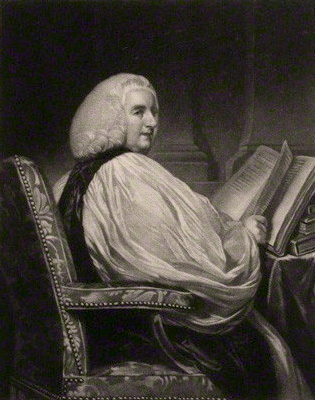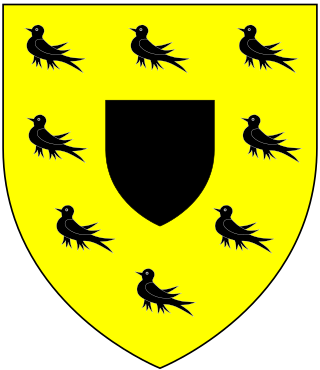
Marquess of Exeter is a title that has been created twice, once in the peerage of England and once in the peerage of the United Kingdom. The first creation came in the peerage of England in 1525 for Henry Courtenay, 2nd Earl of Devon. For more information on this creation, which was forfeited in 1538, see Earl of Devon.

Earl of Gosford is a title in the Peerage of Ireland. It was created in 1806 for Arthur Acheson, 2nd Viscount Gosford.

Earl of Powis (Powys) is a title that has been created three times. The first creation came in the Peerage of England in 1674 in favour of William Herbert, 3rd Baron Powis, a descendant of William Herbert, 1st Earl of Pembroke. In 1687, he was further honoured when he was made Marquess of Powis.

Earl of Caledon, of Caledon in the County of Tyrone, is a title in the Peerage of Ireland. It was created in 1800 for James Alexander, 1st Viscount Caledon. He was a merchant who had made an enormous fortune in India. He also represented the constituency of Londonderry City in the Irish House of Commons. Alexander had already been created Baron Caledon in 1790 and Viscount Caledon, of Caledon in the County of Tyrone, in 1797, also in the Peerage of Ireland. In 1784, James Alexander purchased a city house in Dublin at Rutland Square where he lived when serving as an MP for Derry.

Viscount Charlemont is a title in the Peerage of Ireland. It was created in 1665 for William Caulfeild, 5th Baron Charlemont.

Viscount de Vesci, of Abbeyleix in the Queen's County, now called County Laois, is a title in the Peerage of Ireland. It was created in 1776 for Thomas Vesey, 2nd Baron Knapton and 3rd Baronet. The title Baron Knapton was created in the Peerage of Ireland in 1750 for the first Viscount's father, John Vesey, 2nd Baronet, who had earlier represented Newtownards in the Irish House of Commons. The baronetcy, of Abbeyleix in the Queen's County, was created in the Baronetage of Ireland on 28 September 1698 for the first Baron's father, Reverend Thomas Vesey, Bishop of Killaloe (1713–1714) and Bishop of Ossory (1714–1730).

Baron Brownlow, of Belton in the County of Lincoln, is a title in the Peerage of Great Britain. It was created in 1776 for Sir Brownlow Cust, 4th Baronet. The Cust family descends from Richard Cust (1622-1700) of The Black Friars, Stamford, who represented Lincolnshire and Stamford in Parliament. In 1677 he was created a baronet, "of Stamford in the County of Lincoln". He was succeeded by his grandson Richard Cust, 2nd Baronet, who married Anne Brownlow, daughter of Sir William Brownlow, 4th Baronet, "of Humby", Lincolnshire, and sister and sole heiress of John Brownlow, 1st Viscount Tyrconnel, 5th Baronet of Belton House, Lincolnshire. The 2nd Baronet's son Sir John Cust, 3rd Baronet, sat as a Member of Parliament for Grantham and served as Speaker of the House of Commons from 1761 to 1770 and in 1754 inherited the Brownlow estates, including Belton, on the death of his childless maternal uncle Viscount Tyrconnel. His son Brownlow Cust, 4th Baronet, represented Ilchester, Somerset, and Grantham in Parliament and in 1776 was raised to the peerage as Baron Brownlow, "of Belton in the County of Lincoln", chiefly in recognition of his father's services. He was succeeded by his son John Cust, 2nd Baron Brownlow, who had sat as a Member of Parliament for Clitheroe, Lancashire, and also served as Lord Lieutenant of Lincolnshire for many years. In 1815 he was created Viscount Alford, "in the County of Lincoln", and Earl Brownlow, both in the Peerage of the United Kingdom. In 1810 the future 1st Earl had married Sophia Hume, a daughter of Sir Abraham Hume, 2nd Baronet, of Wormleybury, by his wife Lady Amelia Egerton, a great-granddaughter of John Egerton, 3rd Earl of Bridgewater.
Baron Keyes, of Zeebrugge, and Dover in the County of Kent, is a title in the Peerage of the United Kingdom. It was created in 1943 for the prominent naval commander Admiral of the Fleet Sir Roger Keyes, 1st Baronet. He is chiefly remembered for his role in the Zeebrugge Raid in 1918, an attempt by the Royal Navy to neutralize the Belgian port of Zeebrugge which was used as a base for German submarine attacks on Allied shipping. Keyes had already been created a Baronet, of Zeebrugge, and of Dover in the County of Kent, in the Baronetage of the United Kingdom in 1919. As of 2010 the titles are held by his grandson, the third Baron, who succeeded his father in 2005. He does not use his title.
Baron Congleton, of Congleton in the County Palatine of Chester, is a title in the Peerage of the United Kingdom. It was created in 1841 for the Whig politician and former Secretary at War and Paymaster of the Forces Sir Henry Parnell, 4th Baronet. His eldest son, the second Baron, devoted his life to religious work and was an early member of the Plymouth Brethren. The latter was succeeded by his younger brother, the third Baron. He served in the Royal Navy and fought at the Battle of Navarino in 1827. His eldest surviving son, the fourth Baron, was a major-general in the British Army and served in the Crimean War and in the Anglo-Zulu War. The latter's eldest son, the fifth Baron, was killed in action in Ypres Salient during the First World War and was succeeded by his younger brother, the sixth Baron. As of 2015, the titles are held by the latter's grandson, the ninth Baron, who succeeded his father in 2015.

Earl of Cavan is a title in the Peerage of Ireland. It was created in 1647 for Charles Lambart, 2nd Baron Lambart. He was made Viscount Kilcoursie, in the King's County, at the same time, also in the Peerage of Ireland. Lord Cavan was the son of Oliver Lambart, who had been elevated to the Peerage of Ireland as Lord Lambart, Baron of Cavan in the County of Cavan, in 1618.

Baron Rokeby, of Armagh in the County of Armagh, was a title in the Peerage of Ireland. It was created in 1777 for The Most Rev. Dr Richard Robinson, Church of Ireland Lord Primate of All Ireland and Lord Archbishop of Armagh, with remainder to his brothers and his father's second cousin Matthew Robinson and the heirs male of their bodies. In 1785 he also succeeded his elder brother as 3rd Baronet according to a special remainder. Lord Rokeby never married and was succeeded in the barony and baronetcy according to the special remainders in the letters patent by his third cousin Matthew Robinson-Morris, the second Baron and fourth Baronet. He was the son of Matthew Robinson, son of Thomas Robinson, son of Sir Leonard Robinson, brother of William Robinson, great-grandfather of the first Robinson Baronet and the first Baron Rokeby. The second Baron was an academic, politician and eccentric. Born Matthew Robinson, he assumed by Royal licence the additional surname of Morris in 1746 on succeeding to the Mount Morris Estate in Monks Horton, Kent through his mother. He never married and was succeeded by his nephew Morris Robinson, the third Baron. He was the elder son of Morris Robinson.

Viscount Tyrconnel was a title in the Peerage of Ireland. It was created in 1718 for Sir John Brownlow, 5th Baronet, Member of Parliament for Grantham and Lincolnshire. He was made Baron Charleville, in the County of Cork, at the same time, also in the Peerage of Ireland. The Brownlow Baronetcy, of Humby in the County of Lincolnshire, was created in the Baronetage of England on 27 July 1641 for William Brownlow. His grandson, the third Baronet, represented Grantham in Parliament. The latter had no surviving male issue and was succeeded by his younger brother, the fourth Baronet. He sat as Member of Parliament for Peterborough and Bishop's Castle. He was succeeded by his son, the aforementioned fifth Baronet, who was elevated to the Peerage of Ireland as Viscount Tyrconnel. The three titles became extinct on Lord Tyrconnel's death in 1754. The Brownlow estates were passed on to the late Viscount's nephew, Sir John Cust, 3rd Baronet, whose son was created Baron Brownlow in 1776.

There have been two baronetcies created for members of the Brownlow family, both in the Baronetage of England. Both titles are now extinct.
Brownlow is a surname. Notable people with the surname include:
Charles Brownlow, 2nd Baron Lurgan KP, was an Anglo-Irish Liberal politician.

Charles Brownlow, 1st Baron Lurgan PC, was an Anglo-Irish politician who sat in the House of Commons from 1818 to 1832, during which time he recanted his Orange Order opposition to Catholic emancipation. He was raised to the peerage in 1839.

William Brownlow, 3rd Baron Lurgan KCVO was an Anglo-Irish aristocrat, landowner, hotel proprietor, and sportsman.

William Brownlow PC (I) of Lurgan, County Armagh was an Anglo-Irish politician.
William Brownlow of Lurgan, County Armagh was an Anglo-Irish Tory politician.
John Cavendish Browne, 3rd Baron Kilmaine was an Anglo-Irish politician and landowner. He was an Irish representative peer (1849–73).














